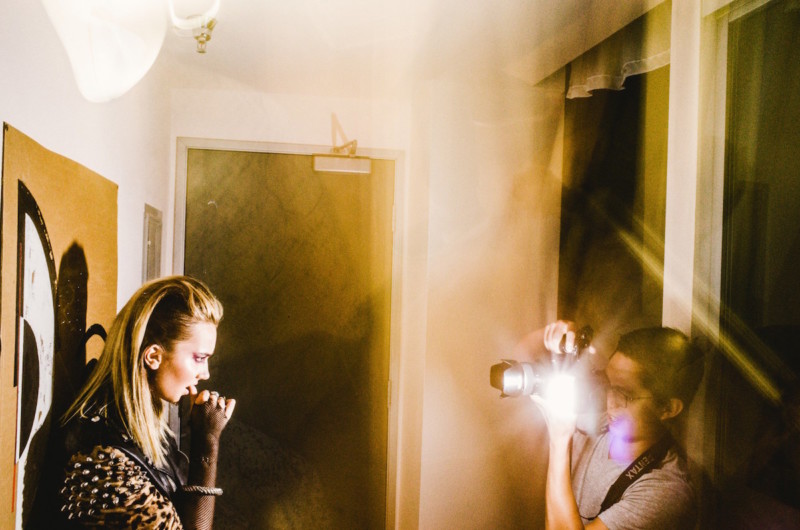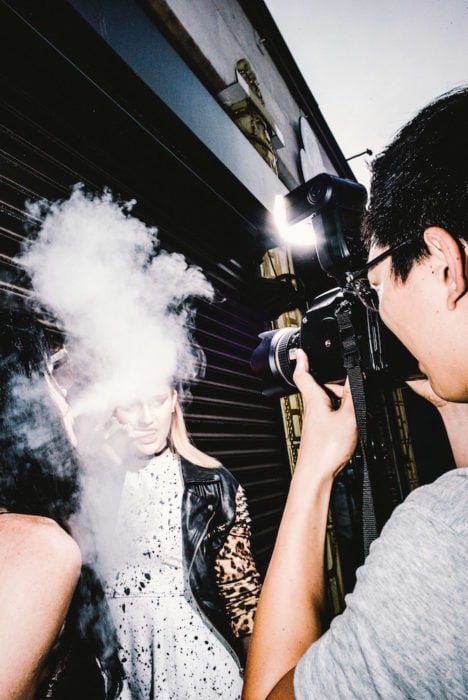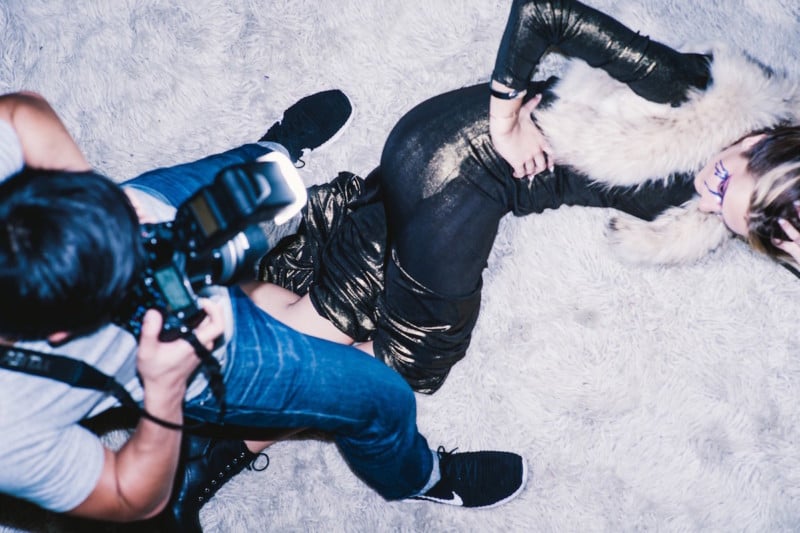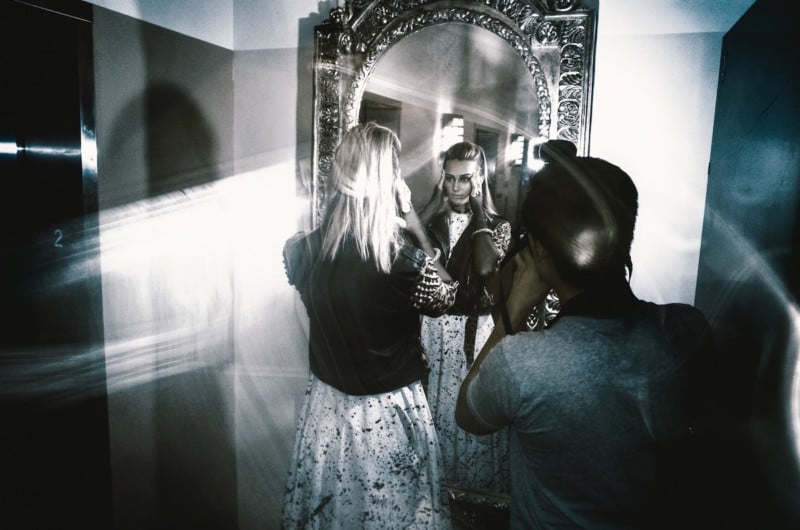7 Lessons Learned On My First Fashion Photography Shoot
![]()
I recently had the great pleasure of shooting fashion photography for the first time with Suede Brooks (model), fellow photographer Bil Brown (he arranged it all), as well with stylists and makeup professionals, and Cindy (creative director, and lighting assistant).
I’ve been interested in shooting fashion for a while now—especially when I first saw the work of Richard Avedon and William Klein (who both had interests in street photography, but did wonderful fashion work). Furthermore other artists like Guy Bourdain, Helmut Newton, Man Ray, and many others showed me how beautiful the human body can be, and how creative fashion can be as well.
1. Shooting fashion is a group-effort
![]()
To start off, I give great thanks to my buddy Bil Brown, who is both a street and fashion photographer, and runs his own magazine (Black and Grey Magazine). He helped coordinate everything, and we did the shoot in Downtown LA near his studio. We did shots both on the streets (where I felt most in the “zone”) as well as in his studio (with a backdrop and professional lights).
One of the first things I learned was how much of fashion photography is a group effort. It isn’t just that the fashion photographer is the rockstar, and everyone obeys his/her whims. Rather, it is the stylists and the makeup team who are God (they control the creative vision), and the photographer is often the person who comes in second.
![]()
Also I was blessed to work with such a wonderful model (Suede Brooks, who is only 15 but acts like she’s double her age).
I’ve found that working with an experienced model makes your job as a photographer 100x easier. Because she was so experienced posing and knowing how to position her body, my job as a photographer was easy—it was about focusing on composition, interesting perspectives, and capturing the “decisive moment.”
2. Cross-pollination with “street portraits” and fashion
![]()
I would say that my experience shooting “street portraits” of strangers on the street definitely helped me shoot fashion. I am generally interested and drawn to people who have “street style” in public—and I’m generally drawn to people with interesting colors, textures, and a sense of personal style.

So when it came to working with Suede, I already felt quite confident. I shot most of the shoot with Bil’s Pentax 645z (biga** medium-format digital camera, with a flash on top), and some on my Ricoh GR II.
I shot it all fully manual on the Pentax—most of the shots at ISO 400, f/16, center-point autofocus, and the flash at 1/4th power (with a Pentax 55mm lens, which is roughly a 35mm full-frame equivalent). These settings worked really well for close-up headshots. When the model was a little further away, I just changed the aperture to f/8 to increase the exposure.
One of the things I tried to focus on was finding a simple yet interesting background. When we were first shooting on the streets, I looked for an interesting backdrop—which tended to be simple black aluminum sliding doors, or even the lights of a movie theater. I also tried to work the scene from different perspectives—with many of the photos shot with me on the ground (back on the ground).
3. What it’s like working with a model
![]()
In terms of direction, I didn’t have to do much (as the model, Suede was already experienced). However, I would ask for subtle changes like for her to lean more towards me, for her to change the position of her body (starting off turned away from me, and then twisting her body towards the camera), and for her to do things like “pretend like you’re screaming” or “play with your hair.”
I found that with fashion shoots, a lot of it is creative direction. Cindy gave a lot of great ideas, like Suede climbing up a ladder, or having her lie on a fur carpet (with me shooting from a high perspective from the ladder).
![]()
The process was also quite exhausting—as the shoot included 4 different outfit changes. So as Bil said, “Don’t blow your load too quickly.” You didn’t want to exhaust all your creative ideas too quickly in the beginning of the shoot (which I kind of did).
4. The importance of mastering technical settings
![]()
In terms of technical settings, I found out that a lot of my photos were under-exposed (especially when shooting in the studio). Shooting on the streets with one flash mounted on the camera was easy; shooting in the studio with two lights (one beauty dish, one fill) was difficult. If you aren’t a studio photographer, you really need to master your lighting before you get a model in the room.
I spent too much time “chimping” and looking at my LCD screen to make sure the exposure looked good, and the direction of the light was good. However, every time I looked at the LCD screen and paused, it killed the “flow” of my interaction with the model.
Lesson: don’t look at your LCD screen while shooting. Set up all your lighting before your model comes, and make sure all your technical settings are on-point. Then spend your time directing the model, and capturing good shots.
5. Shooting what you’re comfortable with
![]()
I also discovered that when shooting fashion, I was a lot more comfortable shooting on the streets. This makes sense—as I am a “street photographer.”

So another lesson is that know what your strengths are as well as your weaknesses. If I were to do more fashion photography, I would definitely focus on shooting on the streets (and not in the studio, where I am not skilled).
Life is short, and I believe it is better to focus on building your strengths, rather than trying to build upon your weaknesses. I figure if I were to do more fashion photography, I would brand myself as a “fashion street photographer”—rather than some fancy studio photographer.
6. Medium-format for fashion is epic
![]()
I shot most of the shoot on the Pentax 645z, and I was really impressed with the quality of the photos afterwards. All I did for post-processing afterwards was apply a “Portra 800 HC” VSCO preset in Lightroom—and the skin tones looked amazing. The photos really do look more “3d” and have incredible detail in the skin.

The 645z is also pretty light (pretty comparable to a Canon 5D Mark III). It is bigger and longer, yet it feels solid in the hand, and the controls are pretty simple. My only complaint is that the 645z’s autofocus is not super-fast… but it’s acceptable.
![]()
The camera is expensive—the body one is ~$7,000. However for a medium-format digital camera, it is a fantastic deal. I wouldn’t recommend this camera unless you are a full-time fashion, commercial, or perhaps wedding photographer, in which you need to blow up the photos really big, or have really nice skin tones.
Also some other random thoughts: if you were a commercial photographer with a passion for street photography, I would probably recommend a combination of getting a compact Ricoh GR II camera for the streets, and a Pentax 645z for your commercial work.
It makes you have a “barbell strategy” of having one small compact camera, and one big camera (rather than a “medium-sized” camera). I don’t plan on buying a 645z, but if you had $7,000 lying around I think the Pentax is a better value camera than a digital Leica.
7. Now I know why I love street photography
![]()
The experience shooting fashion was a blast. I had tons of fun with the rest of the crew, and I enjoyed my ability to be creative and work with the model.
However it also re-affirmed why I love street photography so much. Street photography is so low-maintenance and requires no planning. Bil spent a lot of time and effort coordinating all of us (photographers, model, makeup, stylist, etc)—whereas with street photography, you just go out to take photos.
I imagine the difficulty of a lot of fashion photographers is how much of it is logistics. I would say 90% of the fashion shoot was logistics and planning, and only 10% the actual shooting.

But if you’re a street photographer, I highly recommend you to try shooting fashion. It is a different experience—having to work with a model, work on your lighting and flash skills, as well as being creative on-the-fly.
I hope to do some more fashion work in the future, to improve my “street portrait” skills (and vice-versa). I’ve also learned that shooting a style of photography that is totally foreign and new to me (fashion photography)—I’ve grown as a photographer, learned new skills, and had a ton of fun as well.
Conclusion
![]()
As a takeaway, if you’re curious for a style of photography outside of your comfort zone, try it out. I can guarantee that it will help you learn new skills, techniques, that you can cross-pollinate with any other type of photography you shoot.
I know a lot of wedding photographers find street photography useful, because you need to capture the “decisive moment.” I started off in shooting architecture and landscape photography before I “discovered” street photography—and from architecture/landscape photography I learned composition, framing, and geometry.
The last thing is to always be a beginner. Always be eager to learn new things, stay humble, and know that the only thing worthwhile in life is growth, personal-discovery, and sharing your joy with others.
About the author: Eric Kim is an international street photographer who’s currently based out of Berkeley, California. The opinions expressed in this article are solely those of the author. You can find more of his photography and writing on his website and blog. This article was also published here.